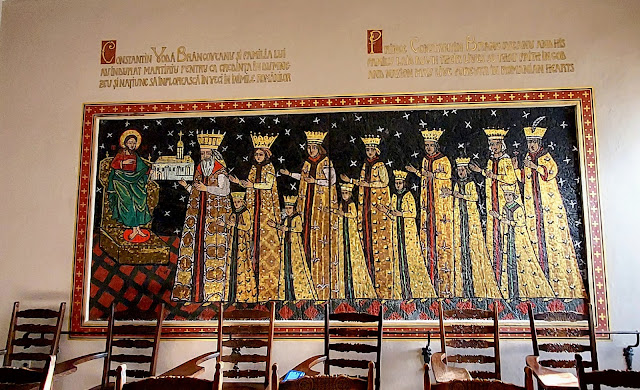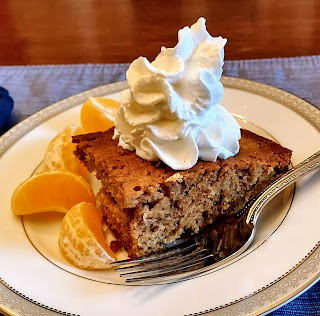Wild, verzweifelnd schaut der Pförtner ausNach den Bahren, die vorüberziehn,
Nach den Bürgern, die der Stadt entfliehen.
Heiβ durchwühlt die Adern ihm der
Zorn,
Ihn verwundert bangen Zweifels Dorn.
Immer neue Bahren ziehn vorbei,
Immer lauter hallt das Wehgeschrei.
Ach! schon fünfmal tausend liegen todt,
Und noch immer mehrt sich Leid und Noth.
Endlich kehrt der Gottgesandte wieder,
Läβt zur Rast sich mit der Alten
nieder;
Doch der Pförtner fährt ihn grimmig an:
,,Tausend, schwurst du, ungefüger Mann!
Und du brachst den Eid?“
Der
Andre spricht:
,,Nein! Denn mehr als tausend schlug ich nicht!
Was darüber, nahm dir diese da,
Stets, auf Schritt und Tritt, war sie mir nah—”
,,Und wer ist dies
Scheufel?“
,,Blicke
hin,
‘s ist die Furcht, die schlimmste Würgerin!“
~ * ~ * ~ * ~ * ~ * ~ * ~ * ~ * ~ * ~ * ~ * ~ * ~ * ~ * ~ * ~ * ~ * ~ * ~ * ~ * ~ * ~ * ~ * ~ * ~
“Cholera and Fear.” By Hermann Friedrichs.
On a
humid night that oppressed matter and spirit, a stranger banged on the door of
the holy city
with the pommel of his sword.
“Hollah, porter, unbar the gate for me!”
The shout boomed gruesomely through the night, and the
guard’s bright eyes looked searchingly at the pilgrim’s countenance: “I do not
trust your voice, stranger! Wait outside until the morning dawns—God has
entrusted me with this city!”
“It is God who sends me!” replied the other roughly. “Come
and examine my escutcheon [crest]. I’ve just cleaned it where the Nile miasma
and desert sandstorm mingle. My sword reaps assiduously when I swing it, [for]
the heat of fever hardens its blade.”
The porter blanched at the horror: “Nevertheless,” he
said, “I will defend my territory against you, if you do not render me the holy
oath, that you will only take a thousand souls. Because I know that you are a
glutton who likes to do more than God has allowed.”
The other swore. The porter let him in. Grimly skulked a shadow
behind him—an old woman, pale and emaciated, burdened with the shield of the omnipotent
one.
Questioningly the porter eyed the figure, but her stare seared
through him, painful and cold. “God, embrace the thousand souls!” he shuddered,
“May they be commended to your care!”
Weeks flew by, and the city filled with terror and dread.
The porter watched with fury and despair as the stretchers passed by and as
citizens fled the city. Hot anger coursed through his veins, as the thorn of
doubt deeply wounded him. Always new stretchers went by, always louder rang the
painful cries. Ach! Already five times a thousand lay dead, and the suffering
and need continued to increase.
Finally, the One sent by God returned with the old woman
and sat down to rest; grimly the porter rounded on them: “A thousand, you promised,
reckless man! Didn’t you break your oath?” And other replied: “No! Because I felled no more than a thousand! What is more, you must understand, she was
always close on my heels—”
“Who is this monster?”
“Look over there, ‘tis Fear, the most terrible
destroyer!”
Citation: Hermann Friedrichs, “Die Cholera und die Furcht,” Die
Gegenwart 26 (1884): 86.
~ * ~ * ~ * ~ * ~ * ~ * ~ * ~ * ~ * ~ * ~ * ~ * ~ * ~ * ~ * ~ * ~ * ~ * ~ * ~ * ~ * ~ * ~ * ~ * ~
Miasmata, citizens
fleeing in panic, a plague sent from God, a moral punch line warning of the
evil of fear itself—surely these are not imagery one would associate with a
modern, industrial, scientifically-advanced country. And yet, this poem was
written not when Europe first encountered cholera in the politically restive
early 1830s,
nor in 1848 when revolution also broke out (again), nor even during repeat
epidemics in 1853-55 or in 1866-75. “Cholera and
Fear” appeared in the weekly family magazine Die Gegenwart in 1884. From Calcutta (now Kolkata), Dr. Robert Koch
(1843-1910) had just announced that he had identified the cause: Vibrio
cholerae. Coming so soon after his identification of Bacillus anthracis in
1896 and Mycobacterium tuberculosis in 1882, it was yet another triumph
for himself and the German state that financed his research in Germany, Egypt,
and India.
Interestingly, at
the dawn of the “bacteriological revolution” (c. 1880-1930), popular imagery of
cholera included both reproductions of drawings of comma-shaped bacteria as
seen through a microscope and vivid, medieval imagery like exotic mists
and sword-bearing phantoms. Hermann Friedrichs’ (1854-1911) poem drew heavily
from motifs of colonialism, Orientalism (West vs East, Europe vs Asia), and
militarized nationalism then circulating in Imperial Germany
I thought a lot
about this poem at the beginning of the COVID-19 pandemic. I considered how
older means of coping with disease and societal disruption mingled with new
discoveries, such as the SARS-CoV-2 genetic sequence and then mRNA vaccines.
While hand washing, mask wearing, and quarantine (or “social distancing”) are
tried and true, we have had a hard time giving up xenophobia and the kind of
isolationist mindset that hoards vaccine until it expires instead of sending it
to low-resource countries. I wonder what future historians will think when they
look back to this period and its ubiquitous spiky virions.


















































